Sukhoi Su-27 Videos
|
Loading...
|
|
Sukhoi Su-27
Su-27
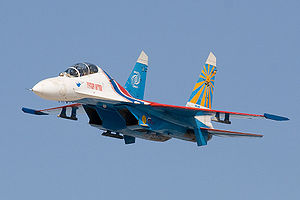
Picture - Su-27UB of the Russian Knights aerobatic team
Role: Air superiority fighter
National origin: Soviet Union / Russia
Manufacturer: Sukhoi Design Bureau
First flight: 20 May 1977
Introduced: December 1984
Status: In production / In service
Primary users: Russian Air Force
Chinese Air Force
Ukrainian Air Force
See Operators for others
Produced: 1984-current
Number built: 680
Unit cost: US$30 million
Variants: Sukhoi Su-30
Sukhoi Su-33
Sukhoi Su-34
Sukhoi Su-35
Sukhoi Su-37
Shenyang J-11
The Sukhoi Su-27 (Cyrillic: Š”ŃŃ Š¾Š¹ Š”Ń-27) (NATO reporting name: Flanker) is a one-seat Mach-2 class jet fighter originally manufactured by the Soviet Union, and designed by the Sukhoi Design Bureau. It was intended as a direct competitor for the large United States fourth generation fighters, with long 3,530 km range, heavy armament, sophisticated avionics and high agility. The Su-27 most often flies air superiority missions, but is able to perform almost all combat operations. Complementing the smaller MiG-29, the Su-27's closest US counterpart is the F-15 Eagle.
There are several related developments of the Su-27 design. The Su-30 is a two-seat, dual-role fighter for all-weather, air-to-air and air-to-surface deep interdiction missions. The Su-33 āFlanker-Dā is a navy fleet defense interceptor for use on aircraft carriers. Further versions include the side-by-side 2-seat Su-34 āFullbackā strike variant and the Su-35 āFlanker-Eā improved air defense fighter.
Development
Background
In 1969 the Soviet Union learned of the U.S. Air Force's "F-X" program, which resulted in the F-15 Eagle. The Soviet leadership soon realized that the new American fighter would represent a serious technological advantage over existing Soviet fighters. What was needed was a better-balanced fighter with both good agility and sophisticated systems. In response, the Soviet General Staff issued a requirement for a Perspektivnyy Frontovoy Istrebitel (PFI, literally "Perspective Frontline Fighter", roughly "Advanced Frontline Fighter"). Specifications were extremely ambitious, calling for long range, good short-field performance (including the ability to use austere runways), excellent agility, Mach 2+ speed, and heavy armament. The aerodynamic design for the new aircraft was largely carried out by TsAGI in collaboration with the Sukhoi design bureau.
When the specification proved too challenging and costly for a single aircraft in the number needed, the PFI specification was split into two: the LPFI (Lyogkyi PFI, Lightweight PFI) and the TPFI (Tyazholyi PFI, Heavy PFI). The LPFI program resulted in the MiG-29, a relatively short-range tactical fighter, while the TPFI program was assigned to Sukhoi OKB, which eventually produced the Su-27 and its various derivatives. The TPFI program is similar to the American F-X program, which resulted in the F-15 Eagle, while the LPFI program is similar to the Lightweight Fighter program, which spawned the F-16 Fighting Falcon and the Northrop YF-17, which itself led to the F/A-18 Hornet.
Design phase
The Sukhoi design, which was altered progressively to reflect Soviet awareness of the F-15's specifications, emerged as the T-10 (Sukhoi's 10th delta wing design), which first flew on 20 May 1977. The aircraft had a large delta wing, clipped, with two separate podded engines and a twin tail. The ātunnelā between the two engines, as on the F-14 Tomcat, acts both as an additional lifting surface and hides armament from radar. While being developed, it was spotted by a spy satellite at the Zhukovsky flight test center near the town of Ramenskoe, resulting in the temporary codename of 'Ram-K'. It was believed that the Ram-K was being developed in two versions: a swing-wing fighter similar in function to the Grumman F-14 and a two-seat fixed wing interceptor aircraft which in fact turned out to be the unrelated Mikoyan MiG-31.
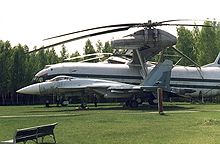
Picture - Su-27 (T-10) in front of a Mil Mi-12.
The T-10 was spotted by Western observers and assigned the NATO reporting name 'Flanker-A'. The development of the T-10 was marked by considerable problems, leading to a fatal crash on 7 May 1978. Extensive redesigns followed, and a heavily revised version, the T-10S, made its first flight on 20 April 1981. This, too, had considerable developmental problems, leading to another fatal crash on 23 December 1981.
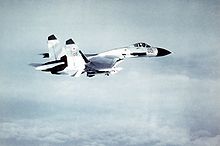
Picture - Soviet Su-27 in-flight.
The production Su-27 (sometimes Su-27S, NATO designation 'Flanker-B') began to enter VVS operational service around 1984, although manufacturing difficulties kept it from appearing in strength until 1986. The Su-27 served with both the PVO and Frontal Aviation. In V-PVO service it was primarily an interceptor, supplanting older aircraft like the Sukhoi Su-15 and Tupolev Tu-28. Although the Su-27 has some capacity to carry air-to-ground weapons, in Frontal Aviation service its primary role was as aerial interdictor, tasked with fighting its way past enemy (presumably NATO) lines to strike tanker and AWACS aircraft. Soviet planners knew that NATO forces possessed an advantage because of these assets, and believed that attacking them directly would limit NATOās ability to maintain an extended air campaign. The Su-27 retains that role in CIS service, with later marks capable of carrying long-range "AWACS killer" missiles such as the Vympel R-37 and, potentially, the Novator K-100 when it enters production.
From 1986 a special Su-27 designated P-42, rebuilt from the prototype T-10S-3 aircraft and stripped to minimum weight, began to set the first in a series of performance records for rate of climb and altitude, the aircraft setting 27 new class records between 1986 and 1988.
Design
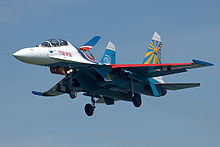
Picture - Su-27 from Russian Knights aerobatic team on landing at Kubinka airbase
The Su-27ās basic design is aerodynamically similar to the MiG-29, but it is substantially larger. It is a very large aircraft, and to minimize its weight its structure has a high percentage of titanium (about 30%, more than any of its contemporaries). No composite materials were used. The swept wing blends into the fuselage at the leading edge extensions and is essentially a delta, although the tips are cropped for wingtip missile rails or ECM pods. The Su-27 is not a true delta, however, because it retains conventional tailplanes, with two vertical tailfins outboard of the engines, supplemented by two fold-down ventral fins for additional lateral stability.
The Su-27ās Lyulka AL-31F turbofan engines are widely spaced, both for safety reasons and to ensure uninterrupted airflow through the intakes. The space between the engines also provides additional lift, reducing wing loading. Movable guide vanes in the intakes allow Mach 2+ speeds, and help to maintain engine airflow at high alpha. A mesh screen over each intake prevents debris from being drawn into the engines during take-off.

Picture - Sketch of Su-27 performing Pugachev's cobra maneuver.
The Su-27 had the Soviet Unionās first operational fly-by-wire control system, developed based on Sukhoi OKBās experience in the Sukhoi T-4 bomber project. Combined with relatively low wing loading and powerful basic flight controls, it makes for an exceptionally agile aircraft, controllable even at very low speeds and high angles of attack. In airshows the aircraft has demonstrated its maneuverability with a Cobra (Pugachevās Cobra) or dynamic deceleration - briefly sustained level flight at a 120° angle of attack. Thrust vectoring has also been tested (and is incorporated on later Su-30MK and Su-37 models), allowing the fighter to perform hard turns with almost no radius, incorporate vertical somersaults into level motion and limited nose-up hovering.
Picture - Undercarriage of Su-27SK
The naval version of the āFlanker,ā the Su-27K (or Su-33), incorporates canards for additional lift, reducing take-off distances (important because the aircraft carrier Admiral Kuznetsov has no catapults). These canards have also been incorporated in some Su-30s, the Su-35, and the Su-37.
In addition to its considerable agility, the Su-27 uses its substantial internal volume for a large internal fuel capacity. In an overload configuration for maximum range, it can carry 9,400 kg (20,700 lb) of internal fuel, although its maneuverability with that load is limited, and normal load is 5,270 kg (11,620 lb).
Picture - Su-27SK at MAKS Airshow 2007
The Su-27 is armed with a single 30 mm Gryazev-Shipunov GSh-30-1 cannon in the starboard wingroot, and has up to 10 hardpoints for missiles and other weapons. Its standard missile armament for air-to-air combat is a mixture of Vympel R-73 (AA-11 Archer), Vympel R-27 (AA-10 'Alamo') weapons, the latter including extended range and IR guided models. More advanced Flanker variants (such as Su-30, -35, -37) may also carry Vympel R-77 (AA-12 Adder) missiles.
The Su-27 has a high-contrast tuneable HUD and a Helmet mounted display capability.
Radar and sensors
The Su-27 is equipped with a Phazotron N001 Zhuk coherent pulse-Doppler radar with track-while-scan and look-down / shoot-down capability. The fighter also has an OLS-27 infrared search and track (IRST) system in the nose just forward of the cockpit with a 80-100 km range, which also incorporates a laser rangefinder. This system can be slaved to the radar, or used independently for "stealthy" attacks with infrared missiles (such as the R-73 and R-27T/ET). It also controls the cannon, providing greater accuracy than a radar sighting mode.
The radar proved to be a major developmental problem for the Su-27. The original Soviet requirement was very ambitious, demanding a multi-target engagement capability and 200 km range against "bombers" (16 m² RCS to match a Tu-16). This would be broadly comparable to the 1-ton Zaslon phased array radar used on the MiG-31.
To achieve this at a reasonable weight, the design team came up with a radar using electronic scanning for elevation and mechanical scanning for azimuth. Unfortunately, it proved too much for the Soviet microelectronics industry in the 1970s to achieve, and by 1982, the original Myesch program had to be abandoned and a less capable alternative array was selected. To make up the lost time, many matured technologies from the N019 Topaz radar, including an enlarged version of the twist-cassegraine array, on the MiG-29 was used, and as a result, the resulting N001 radar shared the same TS100 signal processor used on N019 Topaz radar, while N001V, the successor of N001, shared the same TS101M signal processor with N019M, the successor of N019. The radar only achieved a 140 km detection range versus the Tu-16, and could only engage a single target. Even then, the radar was initially beset by reliability problems and this caused the N001 to be accepted for service in 1991, half a decade after the Su-27 first entered service in 1986.
The first of the N001 series radar, the Tikhomirov (NIIR) N001 (NATO āSlot Backā), is a pulse-Doppler set with track-while-scan capability, but its processor is relatively primitive, making it vulnerable to false alarms and blind spots, as well as being more difficult to use. Over the years, under the chief designer of N001 radar, Professor Viktor Konstantinovitch Grishin, the N001 radar has been upgraded many times, resulting in derivatives including N001V, N001VE, N001VEP, all of which are in service, including those exported Flankers. Professor V.K. Grishin was the chief designer of Zalson S-800 passive phased array radar on MiG-31, and the expertise would later contribute to the design of the replacement phased array radars for the N001 series.
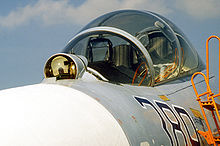
Picture - Su-27UB cockpit showing IRST system
It was apparent that there was limited room for improvement in the N001 series radar, and the Su-30 and Su-35/37 aircraft have the vastly superior Tikhomirov (NIIR) 'Bars' (Panther) N011M with a passive electronically scanned array, improving range, multiple target capability, and sensitivity. The Bars (Panther) radar is scheduled to be replaced by an even more capable successor, Irbis (Snow leopard)-E phased array radar in the near future. Tikhomirov (NIIR)ās competitor, Phazotron (NIIP) also offered a similar radar with a passive electronically scanned array.
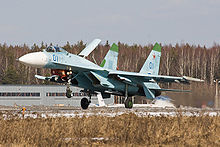
Picture - Su-27 landing at Kubinka, Russia
While the Su-27 and its immediate descendants (Su-35 and -37) have outstanding maneuverability and performance, the airframe design lacks stealth features, so the radar cross section (RCS) is large. The Journal of Electronic Defense reported that "plasma-cloud-generation technology for stealth applications" (Plasma stealth) developed in Russia reduces an aircraft's RCS by a factor of 100. The Russian plasma stealth device had been tested on a Sukhoi Su-27IB by June 2002.
Operational history
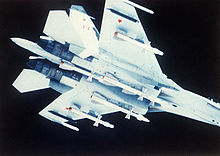
Picture - Su-27 carrying R-27 missiles.
Russia
The Su-27 has seen limited action since it first entered service. These aircraft were used by the Russian air force during the 1992-1993 war in Abkhazia against Georgian forces. One fighter was shot down by an S-75 Dvina on March 19, 1993.
Recently, in the 2008 South Ossetia War, Russia used Su-27s to gain airspace control over Tskhinvali, the capital city of South Ossetia.
On 18 January 2010, Iran denied overflight permission for a Russian Su-27SKM that was enroute to an airshow in Bahrain.
Ethiopia
Ethiopian Su-27s reportedly shot down five Eritrean MiG-29s and damaged another one in February 1999 and destroyed another two in May 2000. The Su-27s were also used in CAP (Combat Air Patrol) missions, suppression of air defense, and providing escort for fighters on bombing and reconnaissance missions. In the War in Somalia (2006-present), the EtAF used their Su-27s to deadly effect, bombing Islamist garrisons and patrolling the airspace. The Su-27 has replaced the aging Mikoyan-Gurevich MiG-21 as Ethiopia's main air superiority fighter.
Angola
The Su-27 entered Angolan service in mid-2000. It is reported that one Su-27 in the process of landing, was shot down by SA-14 MANPADs fired by UNITA forces on 19 November 2000.
Variants
Soviet-era

Picture - Left side scheme of a Sukhoi Su-27 Flanker B, first production series
T10 ("Flanker-A"): Initial prototype configuration.
T10S: Improved prototype configuration, more similar to production spec.
P-42: Special version built to beat climb time records. The aircraft had all armament, radar and paint removed, which reduced weight to 14,100 kg. It also had improved engines.
Su-27 Preproduction series built in small numbers with AL-31 engine
Su-27S (Su-27 / "Flanker-B"): Initial production single-seater with improved AL-31F engine. The "T10P" or "Su-27P" designation is sometimes used for Su-27S single-seaters stripped of secondary strike capability, assigned to Soviet Air Defence Forces units.
Su-27UB ("Flanker-C"): Initial production two-seat operational conversion trainer.
Su-27SK: Export Su-27 single-seater.
Su-27UBK: Export Su-27UB two-seater.
Su-27K (Su-33 / "Flanker-D"): Carrier-based single-seater with folding wings, high-lift devices, and arresting gear, built in small numbers. They followed the "T10K" prototypes and demonstrators.

Picture - Left side scheme of a Sukhoi Su-27 Flanker B, last production series
Post-Soviet era
Su-27PD: Single-seat demonstrator with improvements such as inflight refueling probe.
Su-27PU (Su-30): Two-seat limited production machine with improvements such as inflight refueling probe, fighter direction avionics, new flight control system, and so on.
Su-30M / Su-30MK: Next-generation multirole two-seater. Apparently a few Su-30Ms were built for Russian evaluation in the mid-1990s, though nothing much came of the effort. The Su-30MK export variant was embodied as a series of two demonstrators of different levels of capability. Versions include Su-30MKA for Algeria, Su-30MKI for India, Su-30MKK for China, and Su-30MKM for Malaysia.
Su-27M (Su-35/-37, Flanker-E/F): Improved demonstrators for an advanced single-seat multirole Su-27S derivative. These also included a two-seat "Su-35UB" demonstrator.
Su-27SM (Flanker-B Mod. 1): Upgraded Russian Su-27S, featuring technology evaluated in the Su-27M demonstrators.
Su-27SKM: Single-seat multirole fighter for export. It is a derivative of the Su-27SK but includes upgrades such as advanced cockpit, more sophisticated self-defense electronic countermeasures (ECM) and an in-flight refueling system.
Su-27UBM: Comparable upgraded Su-27UB two-seater.
Su-27M2: 4.5 gen block upgrade for russian Su-27, featuring some technology of the Su-35BM, it includes Irbis-E radar, and upgraded engines and avionics.
Su-32 (Su-27IB): Two-seat dedicated long-range strike variant with side-by-side seating in "platypus" nose. Prototype of Su-32FN and Su-34 'Fullback'.
Su-27KUB: Essentially an Su-27K carrier-based single-seater with a side-by-side cockpit, for use as a naval carrier trainer or multirole aircraft.
Su-35BM/Su-35S: Also dubbed "The Last Flanker" is latest development from Sukhoi Flanker family. It features newer avionics and new radar.
Operators
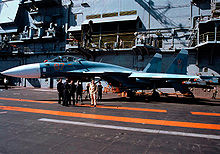
Picture - Russian fighter Su-27K (later designated Su-33) on the deck of Admiral Kuznetsov
Around 680 Su-27s were manufactured by the Soviet Union and Russia. This total includes only Su-27s and not later derivative aircraft.
Angola People's Air and Air Defence Force of Angola. About 8 Su-27 and -27UB. Belarus Belarusian Air Force. Received 23 Su-27s from Soviet Union. Has 18 in service as of January 2009. People's Republic of China People's Liberation Army Air Force. China acquired 53 Su-27SK and 16 Su-27UBK fighters from Russia before signing an agreement in 1998 to licence manufacture the plane as the Shenyang J-11 in China. Approximately 102 J-11 aircraft have been built. Eritrea Eritrean Air Force. About 8 Su-27SK/27UB went to Eritrea in 2003. Ethiopia The Ethiopian Air Force operates 11 Su-27SK, 3 Su-27P, and 4 Su-27UB Indonesia Tentara Nasional Indonesia: Angkatan Udara has 2 Su-27SK and 3 Su-27SKM in service as of September 2010. Kazakhstan The Military of Kazakhstan operates around 30 and is due a further 12 under agreement. Russia Russian Air Force has 445 in service Russia plans to upgrade their aircraft to the Su-27M2 standard, which include new Irbis-E radar, improved engines and avionics, glass cockipt and fly-by-wire, and others.
Russian Naval Aviation. 279th Shipborne Fighter Aviation Regiment is based at Severomorsk-3 with the Northern Fleet. Equipped with Su-25UTG, and Su-33.
Ukraine The Ukrainian Air Force has 74 in service as of November 2008. Uzbekistan The Military of Uzbekistan has 25 in service. Vietnam Vietnam People's Air Force has 12 Su-27SK and 3 Su-27UBK United States Two Su-27s were delivered to the United States in 1995, probably for aggressor training. Two more were bought from Ukraine in 2009.
Private ownership
Two Su-27s from the Ukrainian Air Force were demilitarized and sold to Pride Aircraft of Rockford, Illinois, USA. Pride Aircraft modified some the aircraft to their own desires by remarking all cockpit controls in English and replacing much of the Russian avionics suite with Garmin, Bendix/King, and Collins avionics. The aircraft are currently for sale to private owners for approximately $5 million each.
The Dutch private training support company ECA Program placed an order with Belarus for 15 unarmed Su-27s (with an option on 18 more) for use in dissimilar air combat training. Deliveries are due to be completed by the end of 2012.
Former operators
Soviet Union Soviet Air Force and Soviet Anti-Air Defence
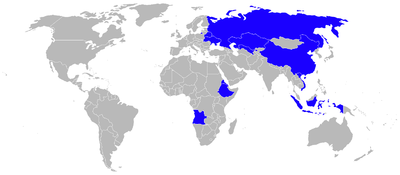
Picture - Operators of the Su-27
See Sukhoi Su-30, Sukhoi Su-33, Sukhoi Su-34, and Sukhoi Su-35 for operators of Su-27 derivatives.
Accidents
September 9, 1990: a Su-27 crashed at the Salgareda airshow in 1990 due to pulling a loop at too low an altitude. The pilot, Rimas A.A. StankeviÄius and a spectator were killed.
December 1998: An Ethiopian Su-27 crashed during a night-flying exercise, killing a pilot.
January 6, 1999: An Ethiopian Air Force Su-27, piloted by a Russian pilot, crashed during test flights. The pilot ejected safely.
July 27, 2002: The Sknyliv Airshow disaster occurred while a Ukrainian Su-27 was performing an aerobatics presentation. It crashed into the crowd and a static display Il-76, killing 85 spectators. Both pilots ejected and suffered only minor injuries.
September 15, 2005: A Russian Air Force Su-27 crashed inside Lithuania.
July 29, 2008: crashed on a training flight in Primorye Territory, Russia at 07:30GMT, 1 pilot was killed but the other survived.
Picture - A Chinese Sukhoi Su-27UBK, a twin-seat version of the Su-27BK
August 16, 2009: While practicing for an airshow, two Su-27s of the Russian Knights collided in mid-air during a test flight 5 km from Zhukovsky Airfield, south-east of Moscow, killing the Knights' leader, Igor Tkachenko. One of the jets crashed into a house and started a fire. This resulted in injuries to five people on the ground, including a woman who received fatal burns. The pilots were training for the 2009 MAKS Airshow. A probe into the crash has been launched; it is thought the accident may have been caused by a "flying skill error", according to the Russian Defense Ministry.
August 30, 2009: A Belarus Air Force Su-27UBM crashed at the 2009 Radom Air Show in Poland. The Su-27 crashed after exiting a loop, possibly due to an engine failure from a bird strike. Both pilots died after opting to stay with the aircraft to steer it away from spectators.
September 20, 2010: A Russian Air Force Su-27 crashed in Russias Far East. Both pilots managed to eject safely and were later rescued.
Specifications (Su-27SK)
Data from Gordon and Davison, KNAAPO Su-27SK page, Sukhoi Su-27SK page,
General characteristics
Crew: 1 or 2
Length: 21.9 m (72 ft)
Wingspan: 14.7 m (48 ft 3 in)
Height: 5.92 m (19 ft 6 in)
Wing area: 62 m² (667 ft²)
Empty weight: 16,380 kg (36,100 lb)
Loaded weight: 23,430 kg (51,650 lb)
Max takeoff weight: 30,450 kg (67,100 lb)
Powerplant: 2x Saturn/Lyulka AL-31F turbofans
Dry thrust: 7,670 kgf (75.22 kN, 16,910 lbf) each
Thrust with afterburner: 12,500 kgf (122.6 kN, 27,560 lbf) each
Leading edge sweep: 42°
Performance
Maximum speed: Mach 2.35 (2,500 km/h, 1,550 mph) at altitude
Range: 3,530 km (2,070 mi) at altitude; (1,340 km / 800 mi at sea level)
Service ceiling: 18,500 m (62,523 ft)
Rate of climb: 300 m/s (64,000 ft/min)
Wing loading: 371 kg/m² (76 lb/ft²)
Thrust/weight: 1.09
Armament
1 x 30 mm GSh-30-1 cannon with 150 rounds
8,000 kg (17,600 lb) on 10 external pylons
Up to 6 x medium-range AA missiles R-27, 2 x short-range heat-seeking AA missiles R-73
Upgraded Su-27SM is capable of using R-77 instead of R-27
Su-27S armament
30 mm GSH-30 Cannon, 150 rounds
6 x R-27R, R-27ER, R-27T, R-27ET
4 x R-73E
FAB-250
FAB-500
B-8
B-13
S-24
S-25
Popular culture
The Su-27 is in a starring role in the SSI flight simulator game "Su-27 Flanker" and sequel "Lock On: Modern Air Combat".
Related development
Sukhoi Su-30
Sukhoi Su-33
Sukhoi Su-34
Sukhoi Su-35
Sukhoi Su-37
Sukhoi Su-47
Shenyang J-11
Comparable aircraft
Eurofighter Typhoon
F/A-18E/F Super Hornet
F-15 Eagle
F-14 Tomcat
Dassault Rafale
"ECA Program Su-27 Flankers Destined for Iceland". Air International. October 2010, Vol. 79 No. 4. p. 9. ISSN 0306-5634.
Gordon, Yefim and Peter Davison. Sukhoi Su-27 Flanker, Specialty Press, 2006. ISBN 978-1-58007-091-1.
Modern Combat Aircraft: Reference guide, pp. 50-51. Minsk, "Elida", 1997. ISBN 985-6163-10-2. (Russian)
Living Warbirds: The best warbirds DVD series.
Source: WikiPedia